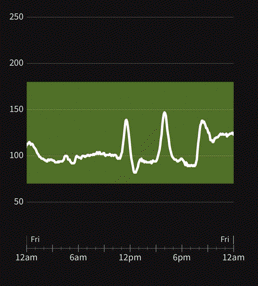Glucose Intolerance & Spikes
We need to reduce glucose and insulin spikes to continue in metabolic health or return to it. This will help us prevent or reduce insulin resistance and glucose intolerance.

Metabolic syndrome is associated with glucose intolerance, higher fasting glucose and insulin levels than normal, obesity, especially an increase in visceral fat and fatty liver, and bad cardiovascular outcomes. The American Heart Association defines metabolic syndrome as being diagnosed with three or more of the following:
- Central or abdominal obesity. This is measured by waist circumference:
- Men: greater than 40 inches
- Women: greater than 35 inches
- High triglycerides: 150 mg/dL or more, or taking medicine for high triglycerides
- Low HDL cholesterol, or taking medicine for low HDL cholesterol:
- Men: less than 40 mg/dL
- Women: Less than 50 mg/dL
- High blood pressure 130/85 mmHg or more, or taking medicine for high blood pressure
- High fasting glucose (blood sugar): 100 mg/dL or more, or taking medicine for high blood glucose.
Glucose levels and spikes are controlled through a healthy diet, exercise, and weight loss. Let's look at glucose in the healthy person, impaired glucose tolerance, urine glucose, and how to control glucose spikes, which can provide insights into how to get rid of metabolic syndrome.
Glucose and Insulin in the "Normal Person" - Fasting
Consider the "normal person," someone without diabetes, metabolic syndrome, obesity, glucose intolerance, or insulin resistance.
In the morning, after an overnight fast and before any breakfast or glucose intake, how does the body get the continuous glucose it needs since the last meal from yesterday is no longer sending glucose from the intestine to the bloodstream?



